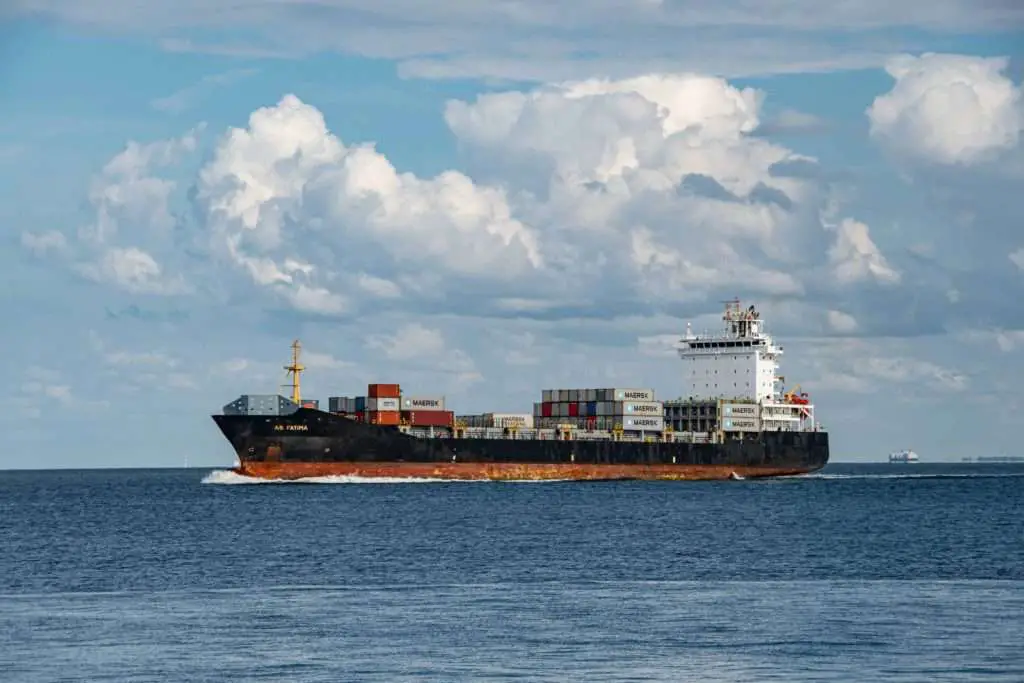
What is displacement?
Displacement is the volume of water a vessel displaces. Displacement weight is the weight of displaced water.
Every floating object displaces equal liquid of its own weight. if the vessel can float in water, the weight of water displaced by this vessel must equal the weight of this vessel.
The displacement tonnage of a ship is the ship’s weight. The displacement of a ship is the volume of water displaced by the ship. The weight of this volume of water, By Archimedes’ principle, is also the weight of the ship.
How to calculate displacement?
Ship displacement is different by cargo load and amenities on board. Empty ships displace less water than fully loaded ships. The heavier the ship is the more volume of water needs displace.
The density of water is also a key factor in deciding a ship’s displacement. For example, that seawater is denser than freshwater, so the same volume of seawater weighs more than fresh water.
It will need more displacement of fresh water than seawater to float the same vessel. That’s why ships float higher in the ocean but sink lower in lakes to displace that much more water.
Displacement Calculator s = ut + (1/2)at^2
Displacement (s) of an object =velocity (u) x time (t) + ½ x acceleration (a) x time squared (t2).
The displacement of ships explained in the below video
lightweight
Lightship weight
Based on en.wikipedia.org Lightship weight or lightweight is the weight of a ship itself, but without fuel, cargo, or crew. Lightship weight is the only weight of the ship and machinery.
Lightship displacement (LDT)
Lightship displacement or light load displacement means the weight of water displaced by a lightweight ship. Since the water displaced by an object equals its own weight, Lightship displacement equals light ship weight.
Deadweight
The dead weight of a ship
www.sidmartinbio.org pointed out that a Deadweight is the maximum amount of weight in tonnes that a vessel can carry. The deadweight of a ship is the total weight of cargo, fuel, crew, fresh water, supplies, etc.
Deadweight tonnage (DWT)
Deadweight tonnage is the measure of how much weight a vessel can carry.
Displacement mass
Displacement mass (m) = Density (p) x Volume (v)
The mass of displaced water equal to the mass of the vessel
The total weight of the vessel (the weight of the vessel itself plus cargo) must equal the weight of displaced water, otherwise, the ship will not float in water.
What is the tonnage of a ship?
Tonnage is not a reference to the weight of a cargo ship. It refers to how much capacity can a ship carry cargo. Tonnage is more of a metric for the government to levy taxes, fees, etc.
A merchant ship weighing 47,000 tons might be able to carry 70,000 tonnes of cargo. 70,000 is this ship’s tonnage.
Also Read:
Different types of tonnage
Displacement Tonnage
The displacement or displacement tonnage of a ship is its weight. Based on Archimedes’ principle the weight of the water displaced by the ship equals the ship’s weight.
Standard Displacement Tonnage
Standard displacement tonnage is the ship’s displacement tonnage minus the weight of fuel, and water on board.
Ship’s displacement tonnage – fuel and water = Ship’s standard displacement tonnage
Deadweight Tonnage
Deadweight tonnage is the maximum cargo weight that a ship can carry.
Deadweight tonnage is the total weight of cargo, fuel, suppliers, etc. on board of a ship. A ship can only carry less cargo weight than its deadweight tonnage.
Lightweight Tonnage
Lightweight tonnage is the weight of a ship and its permanent machinery. Lightweight tonnage does not include fuel, water, or any supplies on board the ship
Gross Tonnage (GT)
www.steamshipmutual.com indicate that Gross tonnage means the measure of the overall size of a ship. Gross tonnage also referred as Gross register tonnage (GRT).
Gross tonnage is calculated from the formula:
V ( the volume of a ship’s enclosed spaces in cubic metres) multiple K1 ( a constant calculated by K1 = 0.2 + 0.02 log10 V.)
GT = K1V
You will use gross tonnage to register your ship if you are a ship owner. You also pay your registration fee, port charges, dock fees, etc. based on your ship’s GT.
Net Tonnage (NT)
Based on en.wikipedia.org that net Tonnage means the measure of the useful capacity of a ship. You also need your ship’s net tonnage for registration, so people also refer to net tonnage (NT) as net register tonnage (NRT)
Both gross tonnage and net tonnage are not the ship’s weight. Gross and net tonnage are measurements of a vessel’s carrying volume. Gross and net tonnage are mainly for registration and collecting fees.
Gross tonnage and net tonnage explained in this video
Differences between displacement and tonnage
Measurement
Displacement is the volume of water that a vessel displaced.
Displacement weight is the weight of water that a vessel displaced. Displacement weight is the measurement of a ship’s weight. A ship’s displacement tonnage is the same as its displacement weight.
Gross and net tonnage are the measurements of a ship’s interior volume.
Purpose
Displacement is a very popular measurement for vessels in the shipping field
Gross tonnage or net tonnage is mainly for registration and levying of fees purpose
Summary
The vessel is large and heavy so it is difficult to weigh the vessel. A vessel’s weight is always changing by how many cargoes are loaded on board. That’s why people use displacement regularly to mention ships instead of ship’s weight.
Gross tonnage is also a popular measurement of vessels, especially commercial vessels. The government used gross tonnage as a measurement to collect fees and levy tax on merchant ships.
